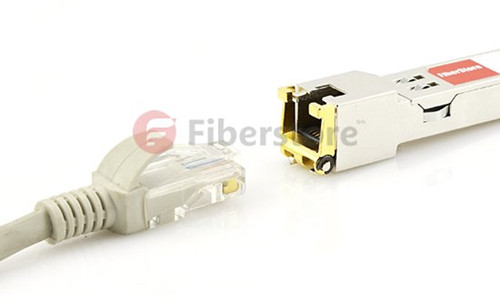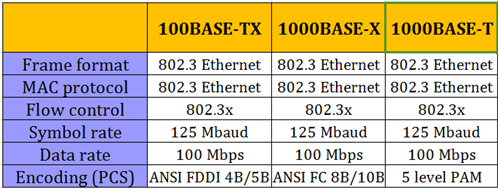With the massive applications of bandwidth-related products in telecommunication networks, people may encounter a dilemma of whether to deploy fiber-based or copper-based infrastructure. Limited budget always comes as an essential factor deciding people’s choice, under this circumstance, copper cabling or 1000BASE-T proves to be a nice and cost-saving method.
What Does 1000BASE-T Mean?
1000Base-T is a shorthand designation by the Institute of Electrical and Electronics Engineers (IEEE). The 1,000 refers to the transmission speed of 1,000 Mbps, while “base” refers to baseband signaling, which means that only Ethernet signals are being carried on this medium. The “T” refers to the twisted pair cables this technology uses. The following image shows a compatible Finisar FCLF8521P2BTL.
1000Base-T is a shorthand designation by the Institute of Electrical and Electronics Engineers (IEEE). The 1,000 refers to the transmission speed of 1,000 Mbps, while “base” refers to baseband signaling, which means that only Ethernet signals are being carried on this medium. The “T” refers to the twisted pair cables this technology uses. The following image shows a compatible Finisar FCLF8521P2BTL.

1000Base-T is a type of gigabit Ethernet networking technology that uses copper cables as a medium. 1000Base-T uses four pairs of Category 5 unshielded twisted pair cables to achieve gigabit data rates. The standard is designated as IEEE 802.3ab and allows 1 Gbps data transfer for distances of up to 330 feet.
Comparison Between 100BASE-TX, 1000BASE-X, and 1000BASE-T
1000BASE-T is one of the four physical layers or transceivers defined by the two Gigabit Ethernet standards: IEEE 802.3z or 1000BASE-X and IEEE 802.3ab or 1000BASE-T. The following text will describe the comparison between 100BASE-TX, 1000BASE-X, and 1000BASE-T in details. Firstly, let us see the table below.
1000BASE-T is one of the four physical layers or transceivers defined by the two Gigabit Ethernet standards: IEEE 802.3z or 1000BASE-X and IEEE 802.3ab or 1000BASE-T. The following text will describe the comparison between 100BASE-TX, 1000BASE-X, and 1000BASE-T in details. Firstly, let us see the table below.

1000BASE-X supports multi-mode and single-mode fiber media and a short-reach, 25-meter copper jumper. As most of the cabling installed inside buildings today is Category 5 copper, the IEEE 802.3 1000BASE-T standard supports Gigabit Ethernet operation over the Category 5 cabling systems installed according to the specifications of ANSI/TIA/EIA-568A (1995). 1000BASE-T, however, works by using all four of the Category 5 pairs to achieve 1000 Mbps operation over the installed Category 5 copper cabling. 1000 Mbps data rates are achieved by sending and receiving a 250 Mbps data stream over each of the four pairs simultaneously.
In contrast, 100BASE-TX uses two pairs: one to transmit and one to receive. Fast Ethernet on Copper (100BASE-TX) achieves 100 Mbps operation by sending encoded symbols across the link at a symbol rate of 125 Mbaud. A 125 Mbaud symbol rate is required because the 100BASE-TX encoding scheme (called 4B/5B coding) has a bandwidth overhead of 20 percent, the difference between 100 Mbps and 125 Mbaud. Although 1000BASE-T uses a different encoding scheme (five level pulse amplitude modulation or PAM-5), because it maintains the 125 Mbaud symbol rate of 100BASE-TX, 1000BASE-T is backwards compatible with 100BASE-FX at the physical layer.
This compatibility feature is significant for network managers and planners because it means that forthcoming generations of 1000BASE-T NICs and switches will support both 100/1000 and 10/100/1000 autonegotiation between Fast Ethernet (100BASE-TX) and Gigabit Ethernet (1000BASE-T). These speed-agile products will enable network managers to deploy 1000BASE-T incrementally into the network.
Fiberstore Compatible 1000BASE-T Transceiver
1000BASE-T is a time-saving and cost-effective solution. Various products have been provided to enhance the 1000BASE-T performances. Fiberstore provides a wide range of 1000BASE-T transceiver modules including FCLF8521P2BTL, AA1419043-E6 and SFP-1GE-FE-E-T. Please feel free to contact us for more information about 1000BASE-T transceivers.
1000BASE-T is a time-saving and cost-effective solution. Various products have been provided to enhance the 1000BASE-T performances. Fiberstore provides a wide range of 1000BASE-T transceiver modules including FCLF8521P2BTL, AA1419043-E6 and SFP-1GE-FE-E-T. Please feel free to contact us for more information about 1000BASE-T transceivers.

Thank you for sharing the information.
ReplyDeletePassive Networking
Structured Cabling
Thank you for the information structured cabling service
ReplyDelete